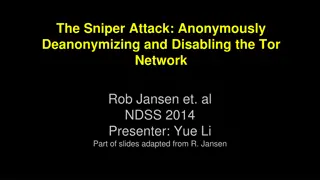Enhancing Tor Network Security and Performance with Tunable Path Selection
This presentation discusses the improvement of security and performance within the Tor network through tunable path selection. It covers Tor's design, proposed methods for bandwidth measurement, router selection algorithms, and the evaluation of different strategies to enhance the network's efficiency. The issues with self-report bandwidth, potential vulnerabilities, and proposed solutions like opportunistic monitoring are also explored.
Download Presentation

Please find below an Image/Link to download the presentation.
The content on the website is provided AS IS for your information and personal use only. It may not be sold, licensed, or shared on other websites without obtaining consent from the author.If you encounter any issues during the download, it is possible that the publisher has removed the file from their server.
You are allowed to download the files provided on this website for personal or commercial use, subject to the condition that they are used lawfully. All files are the property of their respective owners.
The content on the website is provided AS IS for your information and personal use only. It may not be sold, licensed, or shared on other websites without obtaining consent from the author.
E N D
Presentation Transcript
Improving Security and Performance in the Tor Network through Tunable Path Selection Robin Snader and Nikita Borisov Presented by Zechun Cao
Overview Tor Design Proposed Method Bandwidth Measurement Router Selection Algorithm Evaluation and Discussions
Tor Design Tor connects client and destination server by a 3-node circuit As of Oct 2016, Tor has more than 7,000 routers available around the world
Tor Design How does Tor select the path? Tor adopts self-report bandwidth mechanism Every router registered with a directory service Periodically report the peak bandwidth achieved over a period of time, upper bound is 10MB/s Tor constructs circuit weighted by the reported bandwidth to balance the traffic
Tor Design Potential problems Self report bandwidth value is not verified in any way, vulnerable to hackers Fast changing network condition makes bandwidth prediction inaccurate, highly variable performance Tor native load-balancing algorithm is a single, static compromise between performance and anonymity
Tor Design CDF of the time required to transfer a 1MB file over the Tor network in July of 2007 CDF of the time required to transfer a 1MB file over the Tor network in July of 2009
Proposed Method How is the performance of a router measured? Opportunistic monitoring Evaluation aggregation Tunable Router Selection Algorithm
Bandwidth Measurement Three Methods to Consider Tor native method self report Active probing oUses up valuable bandwidth resources oIncreases the risk of failure or compromise Opportunistic monitoring
Opportunistic Monitoring Passive Observation Each router in the Tor network keeps track the bandwidth it has recently seen for each of its peers Around 800 routers contacted within a single day Results aggregated and uploaded to directory server Directory server aggregates ?2 observations to ? evaluations
Opportunistic Monitoring (a) Accuracy of probing for bandwidth prediction in real Tor network (b) Accuracy of passive observation for bandwidth prediction in real Tor network (c) Accuracy of advertised bandwidth for bandwidth prediction in real Tor network
Evaluation Aggregation Multiple observations of a router by a single node Take the Max of observed values over a long interval Partition attacks, where attacker focuses all of its bandwidth on nodes of interest, thus those nodes are more likely to be selected Spotlight attacks, where attacker focuses all of its bandwidth of one node at a time for a single interval
Evaluation Aggregation Multiple observations of a router by a single node Moving average of recent observations ????= ? ? ????+ ????? If attacker ignores a node for a sufficient period of time, that node s estimation of the attacker will drop Suffer from bandwidth fluctuations
Evaluation Aggregation Multiple observations of a router by a single node Min-Max weighted moving average ????= ? ? ???(????,????) + ? ???(????,????) Carries advantage from moving average aggregation But allows bandwidth increase rapidly, and decay slowly if poor service is provided
Evaluation Aggregation Multiple observations of a router by multiple nodes Median-of-five Measurement Queries five nodes, and take the median value EigenSpeed Measurement A node uploads its own observation vector by incorporating the observations of other nodes, weighted by their observed bandwidth. Higher bandwidth capacity can estimate other nodes capacities more accurately, forcing attackers to spend resources to attack the system
Evaluation Aggregation (b) Current Tor bandwidth measurement vs. achieved bandwidth (r=0.176) (a) Actual node bandwidth vs. achieved bandwidth (r=0.223) (c) Median-of-five bandwidth measurement vs. achieved bandwidth (r=0.680) (d) EigenSpeed bandwidth measurement vs. achieved bandwidth r=(0.881)
Evaluation Aggregation Fig. Fractional network utilization for the bandwidth evaluation algorithms presented
Tunable Router Selection Algorithm Flexibility between performance and anonymity Given a list of routers and their rankings If the list is indexed from 0 (? 1) The selected router is that with the index [? ??(?)] ??? =1 2?? 1 2?, ??: 0,1 [0,1] For example, s=15 implies among 1,700 routers, the most highly ranked router will be chosen 23% of the time
Tunable Router Selection Algorithm Fig. Cumulative distributions of routers selected by ranking for some selection levels
Tunable Router Selection Algorithm Features to Note Router selected based on ranking, not metric itself, hackers have to put more resources ?? is well defined for all real ?, negative value could result in picking low bandwidth router Coin toss strategy used to pick between know routers group and new routers group
Tunable Router Selection Algorithm Discovering Selection Level with Single Path With single malicious router, hacker trains na ve Bayesian classifier with 100,000 paths. Then applies the classifier to another 100,000 paths for evaluation. Uniform dataset achieves 4.568 in absolute average value, 4.567 in skewed dataset, in which level 0 is chosen 20% of the time, level 15 at 52%, all other levels 2% for each
Tunable Router Selection Algorithm Fig. Actual selection level and most likely selection level according to a nai ve Bayesian classifier Fig. Mean and standard deviation of guessed level by actual selection level according to a naive Bayesian classifier, for both a uniform and skewed distribution of selection levels.
Tunable Router Selection Algorithm Discovering Selection Level with Multiple Paths Hackers are able to correlate tunnels at a single level K-S (Kolmogorov-Smirnov) tests whether an empirical distribution fits a hypothesized distribution For each selection level, 500 exit router one at a time, after each choice the range of selection levels passing the K-S test is recorded. The experiment repeats 100 times at each selection level.
Tunable Router Selection Algorithm It decreases most quickly for the lower selection levels The possible selection level range is reduced to only three possibilities after only 50 observations at level 1 But takes nearly five times as many observations to reduce the possibilities that far for selection level 13 How many observations we need? Fig. Average range of possible selection levels according to a known-distribution Kolmogorov-Smirnov test
Tunable Router Selection Algorithm Stopping when only one level passes K-S test, it works well for intermediate selection levels Selection level 1 is misidentified as selection level 0 nearly 80% of the time Selection level 13 being misidentified as selection level 15 a substantial fraction of the time Fig. First unique matching selection level according to a known- distribution Kolmogorov-Smirnov test
Evaluation and Discussion Whole System Evaluation Performance Real Tor Network: Only one router is deployed Simulated Tor Network: All routers are deployed Anonymity
Evaluation and Discussion Performance in Real Tor Network Deploy Tunable Tor to a single client Keep exit router, host server fixed, while intermediate routers are chosen based on the proposed method Approximately 40,000 trials for native Tor client, 20,000 trials for Tunable Tor client Download 1MB file over HTTP protocol
Evaluation and Discussion Fig. Cumulative distribution of transfer times for a 1MB file for vanilla Tor and several selection levels in real Tor network Fig. Cumulative distribution of transfer times for a 1MB file for vanilla Tor and several selection levels in simulated Tor network
Evaluation and Discussion Anonymity Fig. The fraction of tunnels compromised if an attacker compromises the top given fraction of Tor routers, for vanilla Tor and for various selection levels Fig. Gini coefficient of router selection equality by selection level
Thank you! Thank you! Questions?























